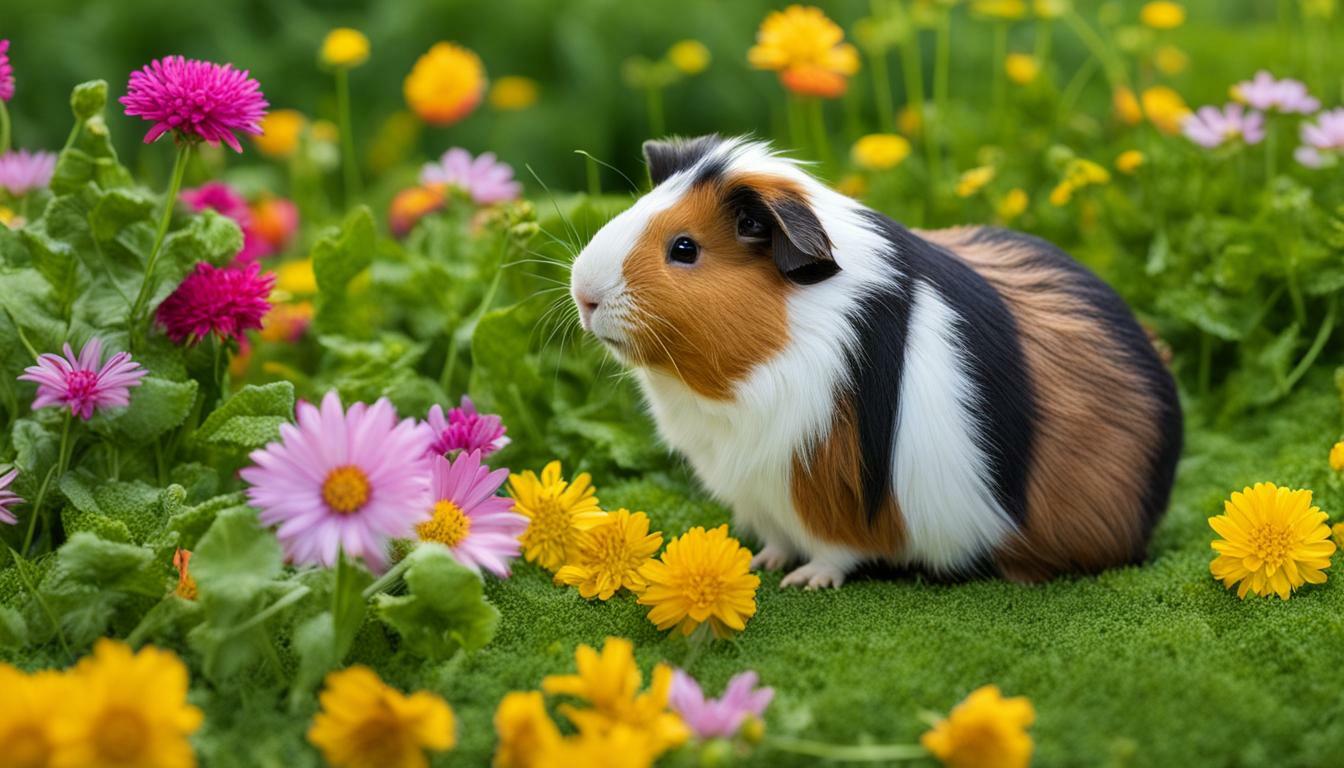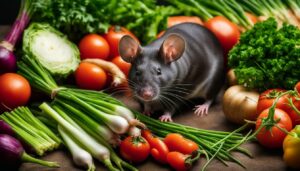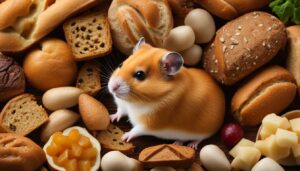Have you ever wondered if it’s safe for your guinea pig to eat endive? Guinea pigs can safely enjoy this leafy vegetable from the chicory family as part of their diet. Not only is endive packed with essential vitamins and minerals, but it also offers a low-calorie, low-fat, and low-sugar option for your furry friend. However, there are a few precautions to keep in mind when incorporating endive into their meals.
Key Takeaways:
- Endive is a safe and healthy vegetable for guinea pigs to eat.
- It is rich in vitamins and minerals, such as vitamin C and vitamin A.
- Endive should be served in moderation, about 2 to 3 times a week.
- Slowly introduce endive to your guinea pig’s diet and watch for any signs of allergic reactions.
- Properly wash and prepare endive before feeding it to your guinea pig.
The Nutritional Benefits of Endive for Guinea Pigs
Endive is not only a tasty treat but also a nutritious addition to your guinea pig’s diet. This leafy vegetable from the chicory family is packed with essential vitamins and minerals that contribute to your pet’s overall health.
First and foremost, endive is an excellent source of vitamin C, which is crucial for guinea pigs as they cannot produce this vitamin on their own. Vitamin C helps support a healthy immune system, aids in the absorption of iron, and promotes collagen production, which is essential for maintaining healthy skin and connective tissues.
In addition to vitamin C, endive also contains vitamin A, which is vital for good vision, immune function, and cell growth. This nutrient works alongside other antioxidants found in endive, such as beta-carotene and lutein, to protect your guinea pig’s cells from damage caused by free radicals.
| Nutrient | Amount per 100g |
|---|---|
| Vitamin C | 11.6mg |
| Vitamin A | 1448 IU |
| Dietary Fiber | 3.1g |
Furthermore, endive is low in calories, fat, and sugars, making it an ideal vegetable for maintaining a healthy weight in your guinea pig. The high fiber content of endive supports a healthy digestive system, preventing issues such as constipation or diarrhea.
When feeding endive to your guinea pig, remember to do so in moderation. Aim for about 2 to 3 times a week and rotate it with other leafy vegetables to offer a varied and balanced diet. Always introduce new foods slowly to avoid any digestive upset. Additionally, be cautious of any signs of allergies and consult your veterinarian if you notice any unusual reactions.
Incorporating Endive into Your Guinea Pig’s Diet
To ensure a well-balanced diet, it’s important to know how to properly include endive in your guinea pig’s meals. This leafy vegetable offers numerous health benefits, but it should be served in moderation and rotated with other leafy greens. Here are some tips on how to incorporate endive into your guinea pig’s diet:
Serving Sizes and Frequency
When serving endive to your guinea pig, it’s crucial to provide the appropriate portion size. A good starting point is to offer about 1-2 tablespoons of chopped endive per serving. This amount can be gradually increased or decreased based on your guinea pig’s individual dietary needs and preferences. It’s recommended to offer endive 2-3 times a week, alongside other leafy vegetables like romaine lettuce or spinach, to ensure a varied and well-rounded diet.
Introducing Endive Gradually
Guinea pigs have sensitive digestive systems, so it’s important to introduce endive slowly and monitor their response. Begin by offering a small piece of endive and observe any potential allergic reactions or digestive issues. If your guinea pig shows no signs of discomfort, you can gradually increase the serving size over time. Remember to always consult your veterinarian if you have any concerns about your guinea pig’s diet or health.
| Endive Serving Tips: |
|---|
| Wash the endive thoroughly before serving to remove any dirt or pesticides. |
| Remove any wilted or damaged leaves from the endive. |
| Chop the endive into small, bite-sized pieces for easy consumption by your guinea pig. |
| Offer the endive in a clean food dish or scatter it within your guinea pig’s enclosure for foraging enrichment. |
Remember, a healthy diet for guinea pigs should consist of a variety of fresh vegetables, high-quality hay, and limited amounts of pellets. By following these guidelines and incorporating endive into your guinea pig’s meals, you can contribute to their overall well-being and ensure they receive the necessary nutrients for a happy and healthy life.
Introducing Endive to Your Guinea Pig
When introducing a new vegetable like endive to your guinea pig, it’s crucial to do it gradually. Guinea pigs have sensitive digestive systems, and a sudden change in their diet can cause digestive upset. To prevent any potential issues, follow these steps to introduce endive to your furry friend:
- Start by offering a small piece of endive, about the size of your guinea pig’s paw, as a trial. Observe their reaction and monitor for any signs of discomfort or allergic reactions.
- If your guinea pig shows no adverse reactions, gradually increase the amount of endive over the course of several days. You can do this by adding a small portion of endive to their regular meal or offering it as a separate snack.
- Pay attention to your guinea pig’s overall well-being and any changes in their stool. If you notice any digestive issues or discomfort, reduce the amount of endive or temporarily remove it from their diet. Consult your veterinarian if the symptoms persist.
Remember, each guinea pig is unique, and their tolerance for new foods may vary. Always introduce any new vegetable slowly and in small quantities to ensure their digestive system adapts well to it.
Signs of Allergic Reactions
While endive is generally safe for guinea pigs, it’s essential to watch for any signs of allergic reactions. If your guinea pig experiences any of the following symptoms after consuming endive, discontinue feeding it immediately and consult a veterinarian:
- Excessive scratching or itching
- Skin redness or rashes
- Hives
- Swelling, particularly around the face, mouth, or throat
- Difficulty breathing or wheezing
| Vegetable | Serving Size | Frequency |
|---|---|---|
| Endive | About the size of your guinea pig’s paw | 2 to 3 times a week |
| Curly Endive | About the size of your guinea pig’s paw | 2 to 3 times a week |
| Belgian Endive | About the size of your guinea pig’s paw | 2 to 3 times a week |
| Escarole | About the size of your guinea pig’s paw | 2 to 3 times a week |
Before serving endive to your guinea pig, it’s essential to properly wash and prepare it to ensure their safety and well-being. Guinea pigs have sensitive digestive systems, so taking the time to properly clean the endive can help prevent any potential issues.
To prepare endive for your guinea pig, start by washing it thoroughly under running water. This will help remove any dirt, pesticides, or other contaminants that may be present on the leaves. Gently pat dry the endive with a clean towel or paper towel to remove excess moisture.
Next, trim off the tough stem of the endive and any damaged or wilted leaves. These parts may be difficult for your guinea pig to chew and digest, so it’s best to remove them before serving.
Once you’ve washed and trimmed the endive, you can serve it to your guinea pig. You can place the leaves directly in their cage or chop them into smaller, bite-sized pieces if you prefer.
Table: Preparing Endive for Your Guinea Pig
| Step | Instructions |
|—————————–|———————————————————————-|
| 1. Wash the endive | Thoroughly rinse the endive under running water. |
| 2. Pat dry | Gently pat dry the endive with a clean towel or paper towel. |
| 3. Trim off the stem | Trim off the tough stem and any damaged or wilted leaves. |
| 4. Serve to your guinea pig | Place the endive leaves directly in their cage or chop into pieces. |
By following these simple steps, you can ensure that your guinea pig safely enjoys the nutritional benefits of endive. Remember to introduce new foods gradually and monitor your guinea pig for any signs of allergies or digestive issues. A varied and balanced diet, including leafy vegetables like endive, is essential for your guinea pig’s overall health and well-being.
Different Varieties of Endive for Guinea Pigs
In addition to the standard endive, there are other varieties that can offer some diversity to your guinea pig’s meals. These include curly endive, Belgian endive, and escarole. Each variety has its own unique characteristics and nutritional benefits, allowing you to provide a well-rounded diet for your furry friend.
Curly endive, also known as frisée, is easily recognizable by its curly leaves. It adds texture to your guinea pig’s diet and can be a fun addition to their meals. Belgian endive, on the other hand, has a more compact and elongated shape. It has a slightly bitter taste, which some guinea pigs may enjoy. Lastly, escarole is a leafy green vegetable with broader leaves and a milder flavor than other varieties.
When introducing different varieties of endive to your guinea pig, it is important to observe their preferences and monitor their reactions. Some guinea pigs may have specific preferences for certain varieties, while others may show a preference for the standard endive. It’s always a good idea to offer a variety of options and let your guinea pig decide which they enjoy the most.
Table: Nutritional Comparison of Different Endive Varieties
| Variety | Vitamin C (mg/100g) | Vitamin A (IU/100g) | Dietary Fiber (g/100g) |
|---|---|---|---|
| Standard Endive | 11.7 | 2,428 | 3.1 |
| Curly Endive (Frisée) | 11.6 | 2,464 | 3.5 |
| Belgian Endive | 9.8 | 2,547 | 2.2 |
| Escarole | 17.6 | 1,916 | 2.8 |
The table above provides a nutritional comparison of different endive varieties. As you can see, all varieties are rich in vitamin C, which is essential for guinea pig health. They also offer varying amounts of vitamin A and dietary fiber, contributing to a well-balanced diet for your furry friend.
Moderation and Allergies
While endive is a healthy addition to your guinea pig’s diet, it should be given in moderation and with caution. Guinea pigs have sensitive digestive systems, and introducing new foods too quickly can lead to digestive upset. To avoid any potential issues, start by offering a small amount of endive and gradually increase the serving size over time.
It’s also important to watch for any signs of allergic reactions in your guinea pig. While rare, some guinea pigs may be allergic to endive or other leafy vegetables. Symptoms of an allergic reaction can include itching, rashes, sneezing, or difficulty breathing. If you notice any of these signs, discontinue feeding endive immediately and consult with a veterinarian.
When serving endive to your guinea pig, ensure that it is thoroughly washed and prepared. This includes removing any dirt and pesticides by rinsing it under cool running water. It’s also recommended to cut the endive into small, bite-sized pieces to make it easier for your guinea pig to eat. Remember, always remove any uneaten vegetables from their cage to prevent spoilage and bacterial growth.
Lastly, keep in mind that there are different varieties of endive available, such as curly endive, Belgian endive, and escarole. These variations can provide a variety of tastes and textures for your furry friend. However, always introduce new varieties gradually and observe your guinea pig’s response to ensure they tolerate them well.
| Key Points: |
|---|
| – Offer endive in moderation to avoid digestive upset. |
| – Watch for signs of allergic reactions and discontinue feeding if necessary. |
| – Thoroughly wash and prepare the endive before serving it to your guinea pig. |
| – Introduce different varieties of endive gradually and monitor your guinea pig’s response. |
The Importance of a Balanced Diet for Guinea Pigs
A balanced diet is crucial for maintaining your guinea pig’s health and well-being. Providing your furry friend with the right nutrition ensures they receive all the essential vitamins, minerals, and fiber they need to thrive. One important component of a healthy guinea pig diet is incorporating a variety of vegetables, including leafy greens like endive.
Endive is a fantastic addition to your guinea pig’s diet because it is rich in nutrients while being low in calories, fats, and sugars. It contains high levels of vitamin C, which is essential for guinea pigs as they cannot produce this vitamin naturally. Vitamin C helps support their immune system and overall well-being.
In addition to vitamin C, endive also provides vitamin A, which is crucial for maintaining healthy eyesight, skin, and immune function. The dietary fiber found in endive aids in proper digestion and helps prevent common gastrointestinal issues that can affect guinea pigs. Including endive in their diet can contribute to their overall gut health and regular bowel movements.
| Nutrient | Amount per 100g of Endive |
|---|---|
| Vitamin C | 11.6 mg |
| Vitamin A | 290 IU |
| Dietary Fiber | 1.5g |
To ensure your guinea pig receives a balanced diet, it’s important to serve endive in moderation and rotate it with other leafy vegetables. Aim to incorporate endive into their meals 2 to 3 times a week, alongside other greens like romaine lettuce, kale, and spinach. This variety ensures they receive a wide range of nutrients and flavors.
Remember to introduce endive slowly to your guinea pig’s diet, especially if they are trying it for the first time. Watch for any signs of allergies or digestive upset, such as diarrhea or decreased appetite. If your guinea pig shows any adverse reactions, it’s best to discontinue feeding them endive and consult with a veterinarian.
By providing a balanced diet that includes vegetables like endive, you are taking an important step in promoting the health and well-being of your guinea pig. Remember to wash and prepare the endive properly before serving it to your furry friend. With proper care and nutrition, your guinea pig will lead a happy and healthy life.
Conclusion
In conclusion, incorporating endive into your guinea pig’s diet can provide them with essential nutrients, but it should be done in moderation and with attention to their individual needs. Guinea pigs can safely enjoy endive, a leafy vegetable from the chicory family, which is rich in vitamins C and A, as well as dietary fiber. This low-calorie, low-fat, and low-sugar vegetable can be a healthy addition to their diet.
When serving endive to your guinea pig, it is important to remember that moderation is key. Offering endive 2 to 3 times a week, along with a variety of other leafy vegetables, will help ensure a balanced diet. Rotating different vegetables will provide your guinea pig with a range of nutrients.
Introducing endive slowly and monitoring your guinea pig for any signs of allergic reactions is crucial. Every guinea pig is unique, and it is important to pay attention to their individual needs and preferences. Properly washing and preparing endive before feeding it to your furry friend is also necessary to ensure their health and well-being.
Remember, there are different varieties of endive available, such as curly endive, Belgian endive, and escarole. Including these varieties in your guinea pig’s diet can add variety and texture to their meals, making mealtime more enjoyable for your pet.
By incorporating endive into your guinea pig’s diet in the right way, you can provide them with essential nutrients while promoting their overall health and well-being. Remember to consult with a veterinary professional for specific dietary recommendations tailored to your guinea pig’s needs.
FAQ
Can guinea pigs safely eat endive?
Yes, guinea pigs can safely eat endive. It is a leafy vegetable from the chicory family that is packed with essential vitamins and minerals.
What are the nutritional benefits of endive for guinea pigs?
Endive is a nutritious choice for guinea pigs as it contains vitamins C and A, dietary fiber, and is low in calories, fat, and sugars.
How should I incorporate endive into my guinea pig’s diet?
To incorporate endive into your guinea pig’s diet, serve it in moderation, about 2 to 3 times a week, and rotate it with other leafy vegetables for a balanced diet.
How should I introduce endive to my guinea pig?
It is important to introduce endive slowly to your guinea pig and watch for any signs of allergic reactions.
How should I prepare endive for my guinea pig?
Before feeding endive to your guinea pig, make sure to wash and prepare it properly to remove any dirt or pesticides.
Are there different varieties of endive that can be included in a guinea pig’s diet?
Yes, different varieties of endive, such as curly endive, Belgian endive, and escarole, can be included in a guinea pig’s diet.
Should endive be served in moderation and what should I watch out for?
Yes, endive should be served in moderation to avoid overfeeding. Additionally, monitor your guinea pig for any signs of allergic reactions.
Why is a balanced diet important for guinea pigs?
A balanced diet is crucial for guinea pigs’ overall health and wellbeing, and vegetables like endive play a significant role in providing essential nutrients.
Can you summarize the key points about feeding endive to guinea pigs?
In summary, guinea pigs can safely eat endive, which is nutritious and low in calories, fat, and sugars. It should be served in moderation, introduced slowly, prepared properly, and rotated with other vegetables for a balanced diet. Observation for allergic reactions is important, and a balanced diet is essential for guinea pig health.




